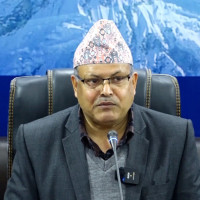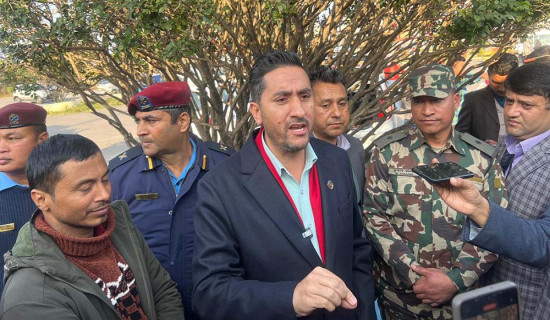- Saturday, 3 January 2026
Tap Bagmati Province's Tourism Potential
Tourism is one of the world’s fastest-growing industries and a major sector for foreign exchange and employment generation for many countries. Tourism brings both economic and non-economic benefits and costs to host communities. Similarly, it can have a negative effect, over-exploitation of natural resources, environmental pollution, waste management, habitat destruction, negative social impacts like increased costs of living for locals and potential cultural erosion.
The tourism sector witnessed rapid growth after the Second World War. It has a competitive advantage all over the world. The invention of modern means of transport, liberal policy of the governments and need of economic development through new and alternative sources of foreign exchange, the rapid growth of population, the increasing interest and desire of the people to experience the different culture, tradition, life of the people and different places of the world etc. are the major factors behind its phenomenal expansion.
Technical advancement
Increasing accommodation facilities and the discovery of jet travel may be the secondary factors to promote it. The scientific and technical advancement, along with material prosperity accompanying a high standard of living, a higher level of education and effective media, made travel attractive for the people of the world. According to the May 2025 World Tourism Barometer from UN Tourism, over 300 million tourists travelled internationally in the first three months of 2025, about 14 million more than in the same months of 2024. That represents a 5 per cent rise on last year and is 3 per cent more than in the pre-pandemic year 2019.
In every global region, tourism stands out as a major services sector, supporting millions of jobs and businesses of all sizes. The number of international tourists is predicted to increase by 3.3 per cent per year up to 2030, reaching 1.8 billion tourist arrivals. Although all areas are set to grow, the fastest growth will be in emerging economies in Asia, Africa and the Middle East.
Bagmati Province, a home to the Kathmandu Valley and stretching from the Churia foothills to the high Himalayas, is the cultural, economic, and tourist centre of Nepal. Its diverse landscapes, deep spiritual roots, and a growing hospitality sector make it the most visited province in the country. Tourism is a cornerstone of economic growth, cultural exchange, and sustainable development in Bagmati Province, Nepal. While tourism has significant growth potential for Nepal, it is a highly competitive industry that requires a major improvement effort. Its success largely depends upon a positive and sought-after image, boosted by significant investment in infrastructure, promotion and branding.
The province boasts a rich cultural heritage, including the UNESCO World Heritage Sites - cultural and natural, diverse natural landscapes ranging from Himalayan foothills to lush valleys, and vibrant communities with unique traditions. These assets position Bagmati Province as a potential premier tourism destination. However, challenges such as inadequate infrastructure, environmental degradation, uncoordinated development, and limited global visibility hinder the realization of this potential.
The province has seven UNESCO World Heritage Sites: the Durbar Squares of Kathmandu, Patan, and Bhaktapur, the stupas of Swayambhunath and Boudhanath, and the sacred Pashupatinath Temple and Changu Narayan. Bagmati is a spiritual magnet. Pashupatinath Temple, one of Hinduism’s most sacred sites and a UNESCO site since 1979, draws tens of thousands of devotees each year. The Chitwan National Park, which is listed as a UNESCO Heritage Site and has been a popular tourism spot since the 1950s, lies in the province.
Outdoor adventure has become a major part of Bagmati’s tourism profile. Trekking routes like Langtang, Helambu, Jiri, Ruby Valley and Chisapani are popular with tourists looking for less-traveled yet stunning Himalayan paths. Day hikes and canyoning at Sundarijal, forest safaris in Chitwan National Park, wildlife watching, elephant rides, rafting on the Trishuli river, and activities like kayaking or bungee jumping along the Bhote Koshi River all contribute to a well-rounded adventure tourism experience.
Challenges
Despite strong efforts, tourism in Bagmati faces challenges. Pollution in the Bagmati River, especially from untreated sewage, harms the spiritual and visual appeal of important heritage areas. Some trekking and hill station trails need better waste management and eco-friendly facilities. However, projects like wastewater treatment plants around Guheshwori and community-led cleanup efforts show promise for local improvements. Tourism in Bagmati Province stands at an exciting crossroads. It combines ancient spirituality, stunning architecture, beautiful natural scenery, and expanding infrastructure.
With solid government support and provincial budgets, the region is working towards a sustainable and inclusive tourism model. Addressing environmental issues, particularly river pollution and trail management, is essential. If handled well, Bagmati can continue to shine as Nepal’s top destination for natural, cultural experiences and adventure, benefiting both local communities and visitors from around the world.
(The author is an ecologist and environmental journalist.)

















